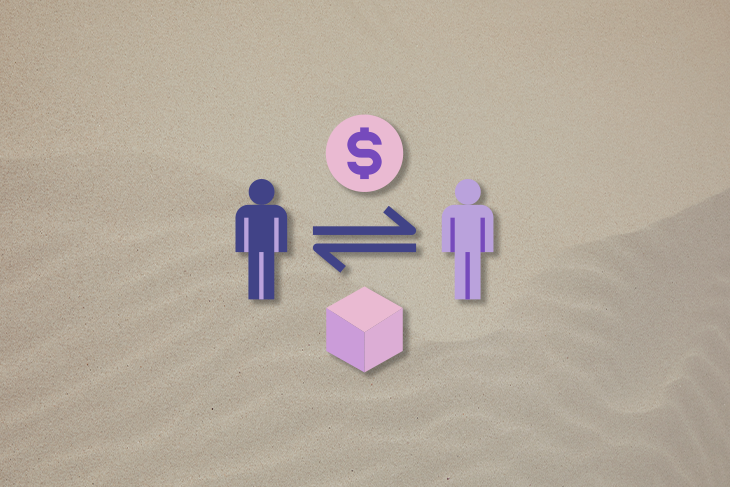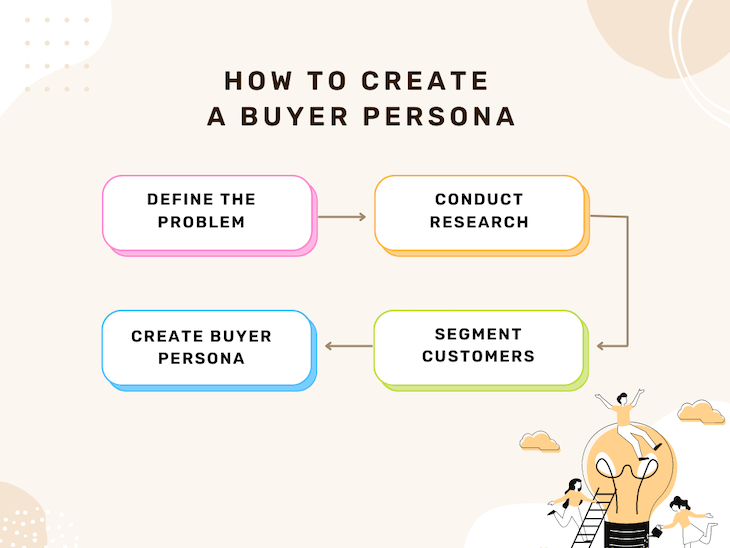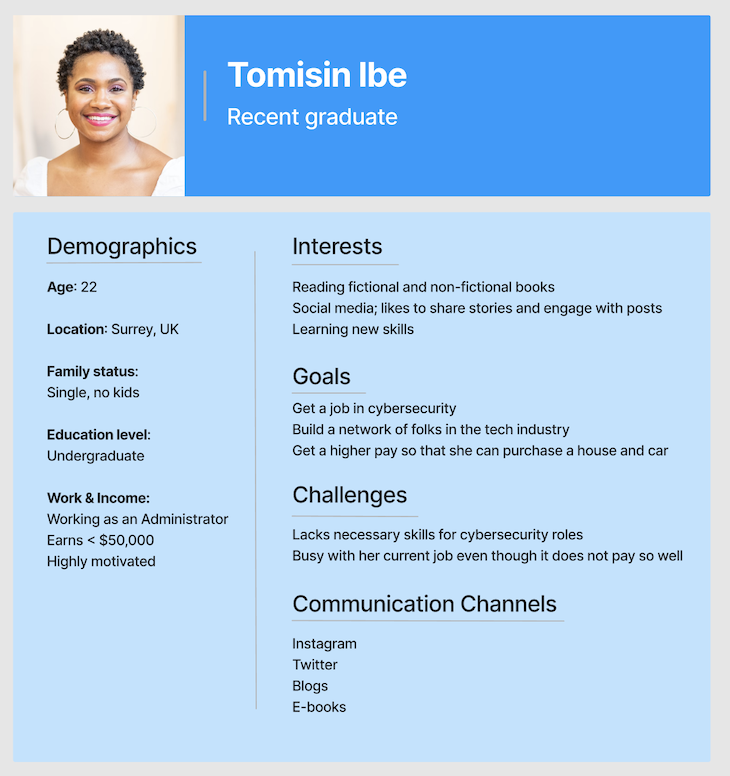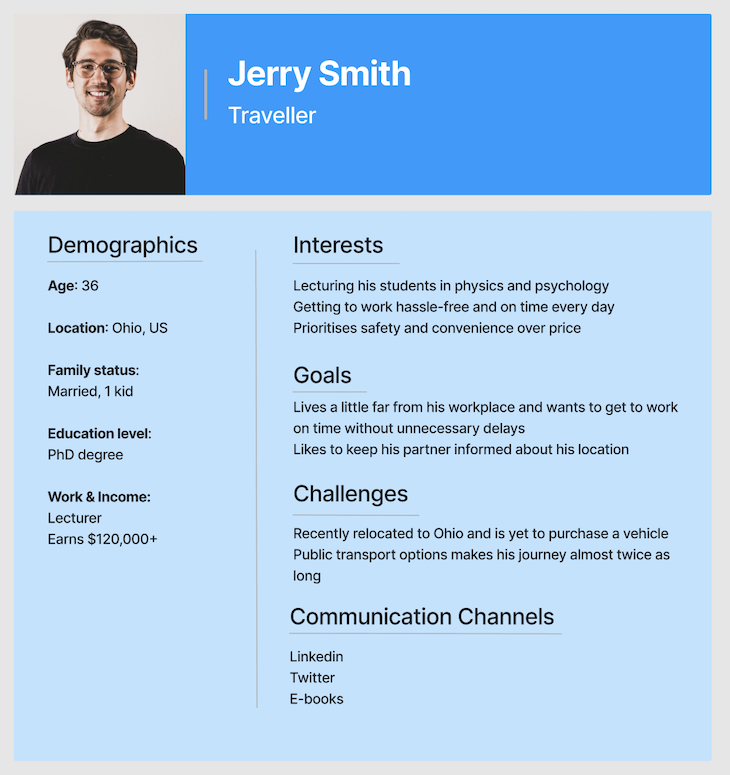A buyer persona is an important concept for any business. If you have been running your business or building a product without buyer personas, this is an opportunity to learn about your customer and introduce processes that enable the team to reference buyer personas for key decision-making.

In this guide, we will discuss what buyer personas are, why they are important, and how to create them. Then, we’ll look into the various ways in which your organization can leverage buyer personas.
To get started, you can download a basic buyer persona template here.
A buyer persona, sometimes called a customer persona or user persona, is a description of a target customer designed to capture who the customer is, what they do, and how they think.
The buyer persona is a fictional character created to properly identify and visualize who is buying your product or service.
The buyer persona typically contains a fictitious name, photo, age, location, occupation, work experience, hobbies, challenges, behaviors, etc.
Both product and marketing teams use buyer personas. Product teams use buyer personas to understand customers’ behaviors and challenges as they build out solutions, while marketers aim to create marketing materials that better target the ideal customers.
Now that we’ve established a better understanding of buyer persona, let’s look at the benefits of using buyer personas.
Creating buyer personas enables you to:
Buyer personas enable you to understand your customers deeply. Creating buyer personas forces you to think about your customers in ways you wouldn’t otherwise and structure your thoughts in an easy-to-read format.
Without buyer personas, you might center your thoughts around, for example, a certain age group, location, or customer need. Creating them allows you to think about who the customer is — their interests, dislikes, experiences, etc. — and appreciate their character.
This, in turn, helps you to better engage with your customers, gain their trust, and truly solve their problems.
For every growing business, it’s easy to get sidetracked by your company goals and objectives. It’s natural for meeting revenue targets and setting up business processes to become the focus for employees.
Having a buyer persona widely referenced across customers helps business and product leaders focus on the customer and their needs rather than the businesses.
A buyer persona is also useful in guiding key business decisions around things like the product roadmap, expansion to new markets, launch activities, marketing strategies, etc.
These strategies and initiatives should be guided by who the buyer/customer is, their needs, and other company objectives. Making decisions based on buyer personas is important for getting the best results.
Buyer personas come in handy for acquiring new customers and retaining existing customers. If business leaders have a thorough understanding of their ideal customers, they can generate more demand from the same target group through recommendations or other marketing engagements.
Creating buyer personas also enables you to keep your existing customers happy because you’re better positioned to serve them and meet their needs.
To create a buyer persona, follow these steps:

Your business exists for a reason, and you have an objective to solve a problem for individuals or organizations.
The first step to creating a buyer persona is defining the problem. Who or which organizations are you solving for? What are they trying to achieve? What challenges are they having? Why does it matter?
At this stage, it is OK to be uncertain about a few things. However, a good understanding of the problem is a basis for further research.
The next step is to research to improve your understanding of the target customer. You may choose to conduct quantitative research (e.g., via surveys) or qualitative research (e.g., via interviews). Qualitative research enables you to engage with interviewees better and dig deeper to clarify comments.
Finding interviewees may be a little tricky, especially if you’re solving a problem in a niche area. A good approach is to reach out to individuals who use your product, those who have shown interest in your company’s objective, and users of competitors’ products. You can use tools like Google Analytics to understand your current audience and Similarweb to understand your competitors’. You can also leverage social media channels and recommendations to reach more people.
When conducting interviews, you want to encourage the interviewee to open up and share honest responses. Don’t ask leading questions. Instead, focus your questions on the individual’s background, behaviors, skills, interests/motivations, and challenges.
You likely have more than one type of customer. For example, an accounting software product focused on solving accounting-related problems might target financial analysts, finance managers, CEO, and other adjacent roles.
At this stage, you want to segment your users based on findings from your research. It is important to segment the market to create targeted products and services. Each customer group will have at least one buyer persona.
Segmentation is company-specific and could depend on certain factors such as location, industry, behaviors, etc.
When categorizing customers by behaviors, you’ll want to answer the following questions:
Now you’re ready to create your buyer persona based on your research.
Each buyer persona will include the following information:
It is important to note that even if you have a B2B product, you should treat buyers and users as individuals.
Now you can share your buyer persona broadly to serve as a guide for internal conversations and key decision-making.
Let’s use two examples to show how buyer personas are created and applied in practice.
Here is an example of a buyer persona created for an e-learning application designed to help users gain technical and soft skills needed for the job market:

Tomisin Ibe is a fictional persona who recently obtained an undergraduate degree and is working as an administrator for a beverage company. However, she is interested in navigating to the tech industry and is particularly fascinated with cybersecurity. She struggles with getting a new job and is faced with a busy schedule, which leaves less time for learning and other personal interests.
Another example of a buyer persona is Jerry Smith, a frequent traveler. This would be a good buyer persona for a ride hailing platform:

Jerry is a fictional character who works as a lecturer in Ohio. He is married and has a child. He recently relocated to the United States and has yet to purchase a vehicle. Hence, he is interested in a transport service that enables him to easily and safely commute to work.
Jerry uses Linkedin and Twitter frequently to connect with peers online.
Now that you have gathered some information about creating a buyer persona, it is time to create one. Fortunately, there are some useful templates you can access online to help you get started immediately.
Here is a simple, easy-to-use buyer persona template you can download and customize using Google Sheets.
This buyer persona template presents the key sections of a buyer persona: demographics, interests, goals, challenges, and channels. You can also easily include additional categories as necessary for your business.
To customize this buyer persona template, select File > Make a copy from the menu bar above the spreadsheet.
This user persona template from Figjam enables you to enter all the pertinent details of your user persona, such as the name, bio, demographics, personality, interests, needs, motivations, and goals. It provides a fun way to collaborate with your team members while creating your personas.
This template from HubSpot is also super easy to use. It presents a walkthrough of the key categories and includes information on why each step is important.
You can download your completed persona right from this tool when you’re done walking through these prescriptive steps.
To show how to apply buyer personas in practice, we’ll look at an example.
Let’s assume you’re managing a ride hailing application. We’ll use the Jerry Smith (traveler) example from above to understand how buyer personas impact business success.
Product managers and businesses use buyer personas for:
Product leaders can use buyer personas to help create product roadmaps when developing products. The buyer persona should be a reference point to explain the “why” behind product decisions.
For example, Jerry prioritizes safety and convenience over price. This could inform features in the product roadmap, such as pickup from home services, ride booking and scheduling options. To enable riders to feel safe, you might consider contracting with only properly vetted drivers making location tracker sharing options available in just a few clicks.
The buyer persona should also inform how the customer interacts with the product — i.e., the user experience (UX) design. Jerry is engaged with Linkedin and Twitter, so the business might apply similar workflows to enable users to easily navigate the application.
Pre-sales activities typically include creating proposals, developing marketing strategies, creating content, etc. Buyer personas are helpful in determining channels to distribute these materials.
For example, using the Jerry persona, we see that he often reads ebooks. The ride hailing company could create an ebook with popular places to visit in the U.S. and include their marketing content within those resources.
Assuming the traveling professional is an ideal customer for your ride hailing platform, the marketing materials could focus on using related keywords/phrases that resonate with this target group. Images on your website or other marketing materials should immediately communicate commuting to work, work-life balance, and convenience to the viewer.
Buyer personas are useful beyond product and sales. It is an essential tool to keep customers happy and retain them.
Creating a buyer persona helps you better understand your clients’ motivations and values. This knowledge should be applied in tackling customer complaints and in your everyday interactions with customers.
For example, Jerry, who uses the ride hailing application frequently, commutes to work and is keen on arriving on tim. Any delay or booking cancellation could make him seem unprofessional.
Therefore, keeping Jerry calm when he contacts customer care is important. Complaints about frequent delays should be resolved immediately to ensure the target group — represented by Jerry — remains satisfied.
I hope this guide gives you a more complete understanding of what a buyer persona is, why it is important, and how to create one, including examples and templates. We also looked at practical ways to leverage buyer personas to achieve business success.
Buyer personas are essential for every business and should be updated regularly. Consumer needs are fast-changing, and their motivations or interests will likely evolve over time in response to trends and changing societal factors. Put simply, organizations that do not have buyer persona or fail to frequently review them risk business failure.
Featured image source: IconScout

LogRocket identifies friction points in the user experience so you can make informed decisions about product and design changes that must happen to hit your goals.
With LogRocket, you can understand the scope of the issues affecting your product and prioritize the changes that need to be made. LogRocket simplifies workflows by allowing Engineering, Product, UX, and Design teams to work from the same data as you, eliminating any confusion about what needs to be done.
Get your teams on the same page — try LogRocket today.

Promotions depend on proof. This guide shows PMs how to capture wins, feedback, and impact before review season.

Most teams fail at autonomy. Learn how clear rules help product teams move faster without micromanagement.

A practical framework for PMs to use AI in ideation without sacrificing judgment, strategy, or decision quality.

A practical five minute revenue estimation method to help product managers compare ideas, drop low impact features, and prioritize smarter.